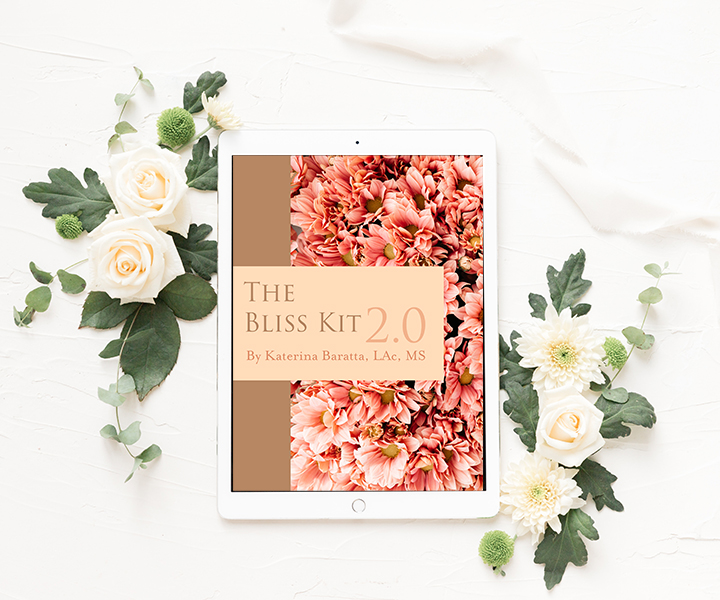Habits and mental health go hand in hand.
What you eat.
How (and how often) you move your body.
When you wake up and when go to sleep.
How much space you create for silence.
The thoughts you think.
How much time you spend outside and how much time you spend on your phone.
The way you respond to others.
Every habit —everything you do, think, and feel— either increases or decreases stress and therefore impacts your mental health.
(Click here to learn more about food and mental health, click here to learn more about movement and mental health, click here to learn more about sleep and mental health, click here to learn how to retrain your thoughts for more ease, joy, and confidence, and click here to learn more about boundaries and creating relationships that support mental health.)
And the vast majority of what you do, think, and feel happens on autopilot, through habit.
Because habits are the most efficient way your brain has found to help your body survive.
Imagine if you had to figure out all of your day-to-day functions afresh, without habit.
You would never get anything done!
It would take forever for you to think through all the steps it takes for you to even get out of bed, let alone brush your teeth or eat breakfast!
Instead, you’re able to just go through the motions, responding to the world in ways that were conditioned in the past.
Through experience, your brain and body have learned what needs to be done to help you survive, and they’ve figured out the most energy-efficient way of doing it.
Habits.
And unless you do something about it, you’ll keep repeating the same behaviors, thoughts, and feelings in the future, because they’re all ingrained in you as habits.
But that’s not what you want!
You don’t want to be kept hostage by your past.
And you definitely don’t want to operate on survival mode all the time.
You want life to get juicier, right?
You don’t just want to survive, you want to flourish!
You want to feel more joyful, more exuberant, more connected, more loved and more loving, more at ease.
You want to know that you’re heading in the right direction.
And by changing your habits you can.
It sounds so simple.
Much of your life is run by habit.
Your mental health depends on your habits.
Change your habits, change your mental health, change your life.
Easy equation, theoretically.
But you know from personal experience that changing habits can feel as impossible as finishing a marathon when you haven’t left your couch in a year.
What gives?
Why is it so hard to get yourself to do the things you know will help you feel better?
It comes down to neurology.
The reason it feels so hard to start a new habit is that every time you think, do, or feel something, electrical impulses are sent from one neuron to another in your nervous system to communicate those messages.
And neurons literally have to move their arms, called dendrites, to get closer to other neurons that they communicate with.
This takes a lot of energy, which your nervous system doesn’t want to waste.
So when you think, feel, or do something often, neurons will fix themselves near the other neurons they communicate with the most, creating neural networks.
Which means that every time you think, do, or feel anything, you’re reinforcing neural patterns that make it easier for you to think, do, or feel something similar in the future.
These neural networks are like roads that carry electric impulses through your brain and body.
And when you repeat a thought, behavior, or feeling often, your neurons build something like a neural highway.
On these neural highways, practiced messages can travel quickly and easily to their destination.
But unpracticed thoughts, behaviors, and feelings -the ones you don’t use as often- have to make new connections, creating side roads that aren’t as quick or easy to follow.
New thoughts, behaviors, and feelings take more time and energy than the ones you use a lot, so your nervous system doesn’t favor them.
Still, the more a path is used, the more established it becomes and the less energy is needed.
And if you use a side-road enough, eventually it can grow into a neural highway.
Similarly, if you divert traffic on your neural highways, eventually they’ll get overgrown with weeds.
They might even look like they’ve disappeared completely if they stay unused.
But it takes time.
And you have to understand where habits are coming from before you can consciously change the flow of traffic in your neural networks.
Charles Duhigg, the New York Times bestselling author of the groundbreaking book, The Power of Habit, describes a powerful phenomenon he calls the Habit Loop that can help with this.
Here’s how Habit Loops work:
Habits start with a cue.
Let’s use an alarm clock as an example.
You hear the alarm, which triggers the next part of the habit, the routine.
The routine is your automatic response to the cue.
So in this example, the routine might be get out of bed, stretch, scratch your head as you walk to the coffee maker, pour yourself a cup, sit down, look at your phone, browse social media for a while, then open Wordle.
Each part of this routine comes with a built in a reward (which is the last part of the Habit Loop).
The reward is what solidifies that neural highway and keeps you coming back to that routine.
You crave the feeling that you get at the end, so you repeat the routine in hopes that you’ll get the same result you got last time.
In this example, each reward serves as the cue for the next bit in the habit loop.
The reward for getting out of bed is that your body gets to stretch and enjoy a scratch, which it’s craving after sleeping for (hopefully) 8 hours.
This helps you wake up just enough to cue your desire for coffee.
Your reward for shuffling to the kitchen (routine) is that you get to drink the coffee, which is tasty and makes you feel a bit more alert (reward).
Sitting down with coffee (routine) makes you a bit restless (reward) and cues your curiosity to see what’s happening in the world.
So you look at your phone (routine) because you’re craving the dopamine hit it gives you (reward).
And because that hit is pretty small, it cues your desire for more, which cues the Wordle puzzle (routine).
You then get rewarded by the sense of satisfaction from solving Wordle in addition to more feelings of connection from sharing your results.
But you’re still left unsatisfied.
You’re still left operating on an autopilot system that’s determined by your mind and body’s singular focus on survival rather than what will help your spirit sour.
Wouldn’t it be great to have a morning routine that helps you embrace life instead of just getting through it?
Maybe you wish you could get yourself to wake up earlier and meditate or go for a run.
Maybe coffee makes you jittery and anxious, but you can’t get yourself to stop drinking it.
Maybe you feel like you’re addicted to your phone and aren’t actually getting the feeling of connection you’re hoping for when you pick it up.
What then?
The good news is that neurology is plastic, which means that you have the power to change your habits.
It takes some intention, attention, effort, and time.
But you can change your Habit Loops and rewire your neurology to create new habits that reduce stress and support your mental health.
And while each situation is different, there are a few strategies I teach the people I work with that have literally changed lives.
1. Start Stupid Small
The first thing you want to do when you start a new habit is to start stupid small.
When you set out to change habits, the temptation is to go big and do all the things at once.
You tell yourself you’re going to commit to 2 hours of yoga every day, stop drinking coffee and alcohol, go to bed early, and banish all negative self-talk from your mind for good.
You imagine you can just conjure up a willpower tornado to sweep through and flattened all of your old habits to rubble.
But that’s not how it works.
Because established neural highways are extremely powerful.
And the more you try to resist them, and the more new habits you try to create at once, the quicker you’ll tire out and revert back to the established route.
So the best way is to “trick” your nervous system by breaking new habits into small and easy steps.
Instead of committing to something big, start with something that is so small it would be stupid not to do it.
For example, instead of committing to 2 hours of yoga every day when you’ve only done 2 hours of yoga in your whole life, start by committing to doing 5 breaths in a forward fold.
You can always do more if you want to once you’re on your mat.
But in the beginning, you’re just committing to showing up for those 5 breaths.
Once that habit is established —once those neural connections have strengthened,— you can add on and commit to more, in this case it might be to do 2 sun salutations.
(I usually give each small step 1-3 weeks before adding more).
2. Set Up Your Environment
Habit loops start with a cue, and these come from your environment.
So one of the best ways to create new habits is to make changes to your environment, and use those changes to cue your new behavior.
Let’s keep going with the yoga example from above.
Help yourself show up for your new daily yoga practice by rolling out your yoga mat the night before, setting an alarm, and laying out the clothes you’ll need.
Take as much decision out of the process as possible so the new habit becomes automatic.
And since you’re starting stupid small, you’ll have no trouble following-through, even if your mind makes up 1000 excuses.
3. Establish a Time-frame
Which sounds more likely: committing to doing yoga every morning for the rest of your life, or committing to doing yoga every morning for a week?
A week, obviously.
Another way to trick your nervous system patrol officers into letting you explore a new habit pathway in the wilderness is by committing to a short time-frame.
Because when you say you want to change something forever, it can be overwhelming to the point of feeling impossible.
It takes a ridiculous amount of energy to create new neural pathways, and your brain really doesn’t want to work that hard.
All that energy pulling your neurons into familiar patterns is exhausting to resist.
Of course, once that highway is established it’ll hardly take any energy at all.
But building that new neural highway can be a daunting task when there’s no end in sight.
Which is why you’re so much more likely to follow through when you’ve established a short-term goal.
You know you can handle a little discomfort for a day, or even a few weeks.
Your brain can make accommodations for a short while.
But trying to get your brain to commit to spending more energy than that is like trying to convince a politician to spend tax dollars on a project that the taxpayers don’t want.
4. Choose Rewards and Consequences
Rewards motivate and consequences discourage.
And when you’re trying to change your habits, it’s helpful to have rewards and consequences in place to steer your behavior.
The ultimate reward you want to go for is the good feeling you get from your new habit.
But in the beginning that’s not enough.
You need a bigger carrot to dangle in front of your own nose if you want to pull the weight of establishing a new habit.
So choose a reward that you’ll give yourself when you’ve (A) successfully shown up for your stupid small habit consistently (B) for your predetermined amount of time.
And you give yourself extra motivation when you choose a consequence.
This should be something you really, really want to avoid.
The thought of this consequence should hurt as much as the thought of a high-voltage electric shock (but please don’t cause yourself physical harm!).
Some people decide to commit $50 to an organization that stands against the things they value most if they don’t follow through.
One of the women who works with me does burpees for each day she doesn’t follow through (she really doesn’t like burpees!)
Whatever consequence you choose, tell someone about it who you know will hold you accountable.
That way you’re much more likely to follow through.
5. Be Consistent
Consistency is key when it comes to new habits.
Remember, the more you repeat a behavior, thought, or feeling, the stronger the neural connections become that make it easier for you to repeat similar behaviors, thoughts, or feelings in the future.
If you don’t show up for your new habit consistently, your neurons will settle back into their familiar pattern to save energy.
As one of my teachers, Jonathan Fields once told me:
“It’s much more effective to do a little yoga a lot than to do a lot of yoga a little.”
And this applies to everything, not just yoga.
If you want to change your life, you’ve got to be consistent.
6. Adopt a Growth Mindset
Growth Mindset and Fixed Mindset are terms coined by Dr. Carol Dweck which describe your underlying belief about learning and intelligence.
A person a with a fixed mindset believes that you’re born with certain traits or talents and these are unchangeable.
It becomes a self-fulfilling prophesy.
Because when you encounter a challenge or set-back with a fixed mindset, you just give up.
You imagine that the challenge or set-back is proof that you aren’t “good enough” and as a result you stop trying.
But if you have a growth mindset, you don’t just expect challenges and set-backs, you see them as opportunities to grow.
And that means you keep going even when it’s uncomfortable and difficult.
Which is how you make the changes you want to make.
7. Use the WOOP Method
And finally, one of the ways I support the people I work with in changing their habits is through the WOOP method.
WOOP is a scientifically proven strategy developed by Dr. Gabriele Oettingen to find and fulfill wishes, set preferences, and change habits.
It basically synthesizes everything we’ve talked about so far in this article.
WOOP stands for Wish, Outcome, Obstacle, and Plan.
First you state your wish, and be specific.
What do you want to change in your life?
If you don’t have a wish in place already, it’s helpful to think of an area of your life that you’d like to improve, like career, health, or relationships.
Choose just one thing you’d like to change.
Something that you might struggle with, but you know you can fulfill.
State your wish in just 3-6 words.
Then give yourself a time-frame.
How long do you want it to take for this wish to be fulfilled?
Now it’s time to think about the outcome you’re going for.
What’s the best possible outcome that could happen when your wish gets fulfilled?
State this outcome in just 3-6 words.
Then close your eyes, imagine this outcome as a reality, and really feel the emotion that’s associated with this outcome in your body.
This step is REALLY important.
Because your brain doesn’t know the difference between something that’s imagined and something that’s really happening.
So when you imagine your outcome, you’re wiring your neurology to favor that outcome.
Now identify your inner obstacles.
What is it within you that’s holding you back from fulfilling your wish?
How do you self-sabotage?
What excuses do you make?
How do you justify yourself when you act in opposition to your wish?
What’s your main inner obstacle? Write this down in 3-6 words.
Now close your eyes again and imagine what it feels like when this obstacle arises.
Where do you feel it in your body? What is your mind telling you?
And then make a plan.
Name one action you can take or one thought you can think to overcome your obstacle.
Write it down like this: “When [obstacle] then I [plan]”.
Repeat your plan to yourself often so it becomes engrained and you don’t even have to think about it.
Now remember, even with a plan in place it’s very likely that you’ll slip up every once in a while.
That’s ok.
It’s part of the growth process, so keep going.
Change one small habit at a time, and pretty soon you’ll look back at your life and it will look totally different.
You’ll be amazed at how much you can grow by using these strategies.
I can’t wait to see where this takes you!





